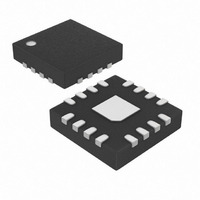MAX4063ETE+T Maxim Integrated Products, MAX4063ETE+T Datasheet - Page 9

MAX4063ETE+T
Manufacturer Part Number
MAX4063ETE+T
Description
IC PREAMP AUDIO STER AB 16TQFN
Manufacturer
Maxim Integrated Products
Type
Class ABr
Datasheet
1.MAX4063ETET.pdf
(15 pages)
Specifications of MAX4063ETE+T
Output Type
2-Channel (Stereo)
Voltage - Supply
2.4 V ~ 5.5 V
Features
Differential Inputs, Microphone, Shutdown
Mounting Type
Surface Mount
Package / Case
16-TQFN Exposed Pad
Lead Free Status / RoHS Status
Lead free / RoHS Compliant
Max Output Power X Channels @ Load
-
Figure 1. MAX4063 with Auxiliary Input Configuration
R
The two differential microphone inputs and the single-
ended auxiliary input of the MAX4063 have on-chip
bias components, allowing the user to AC-couple any
signals into the input. The input resistance is 100kΩ
(typ), so the capacitor size may be chosen accordingly
to define the LF rolloff desired. This can be calculated
as:
This assumes a low source impedance is driving the
inputs.
A further consideration for the differential input is the
effect of these series input capacitors on low-frequency,
common-mode rejection. Any mismatch in the values of
these two capacitors degrades the CMRR at frequen-
cies where the impedance of the capacitor is significant
where:
ADJ
is placed between AUX_IN and ADJ.
AV
Differential Microphone Preamplifier with
C
_______________________________________________________________________________________
AUX
IN
= 1 / (2πf
=
Internal Bias and Complete Shutdown
V
OUT
V
100kΩ
AUX_IN
CUT
− V
R
OUT
IN
)
Input Capacitors
R
BIAS
V
CC
C
BIAS
12
14
10
5
1
9
3
IN+
IN-
BIAS
AUX_IN
G1
G2
SHDN
compared to the input resistance of the amplifier—this is
usually most noticeable at low frequencies. One way to
avoid the need for matched or tight tolerance capaci-
tors is to deliberately oversize the values on the differ-
ential inputs and to set the lower 3dB point (f
amplifier by sizing the output capacitor appropriately.
The input impedance matching on the differential input
is typically 1%, allowing input capacitor matching to be
effective at improving low-frequency PSRR.
The common-mode rejection ratio (CMRR) refers to the
amount of rejection that the amplifier is capable of pro-
viding to any signal applied equally to the IN+ and IN-
inputs. In the case of amplifying low-level microphone
signals in noisy digital environments, it is a key figure of
merit. In audio circuits, this is generally measured for
V
where A
mode gain.
SHDN
V
2.4V TO 5.5V
IN
BIAS
V
as an AC signal:
CC
GND
6
11
MAX4063
DM
INT/AUX
is the differential gain, A
OUT
OUT 4
ADJ
CMRR(dB) = A
7
2
8
Common-Mode Rejection Ratio
DM
/ A
CM
CM
is the common-
CUT
) of the
9












